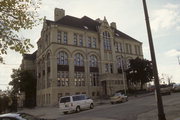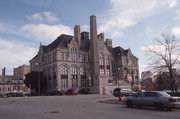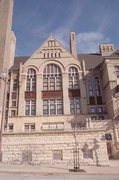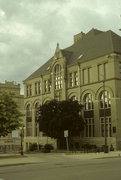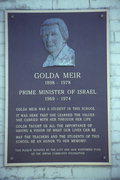Property Record
1542 N N Vel R. Phillips Ave (AKA 1542 N 4TH ST (AKA 1555 N MARTIN LUTHER KING DR))
Architecture and History Inventory
| Historic Name: | Fourth Street School (Sixth District School) |
|---|---|
| Other Name: | Golda Meir Public School |
| Contributing: | |
| Reference Number: | 16740 |
| Location (Address): | 1542 N N Vel R. Phillips Ave (AKA 1542 N 4TH ST (AKA 1555 N MARTIN LUTHER KING DR)) |
|---|---|
| County: | Milwaukee |
| City: | Milwaukee |
| Township/Village: | |
| Unincorporated Community: | |
| Town: | |
| Range: | |
| Direction: | |
| Section: | |
| Quarter Section: | |
| Quarter/Quarter Section: |
| Year Built: | 1890 |
|---|---|
| Additions: | 1912 1906 |
| Survey Date: | 19822019 |
| Historic Use: | elementary, middle, jr.high, or high |
| Architectural Style: | Romanesque Revival |
| Structural System: | Iron Frame |
| Wall Material: | Brick |
| Architect: | H. C. Koch |
| Other Buildings On Site: | |
| Demolished?: | No |
| Demolished Date: |
| National/State Register Listing Name: | Fourth Street School |
|---|---|
| National Register Listing Date: | 8/2/1984 |
| State Register Listing Date: | 1/1/1989 |
| National Register Multiple Property Name: | Multiple Resources of N. 3rd St. - Brewers' Hill |
| Additional Information: | A 'site file' exists for this property. It contains additional information such as correspondence, newspaper clippings, or historical information. It is a public record and may be viewed in person at the Wisconsin Historical Society, Division of Historic Preservation-Public History. ARCHITECTURAL STATEMENT: The Golda Meir School was designed in the Romanesque Revival style by Milwaukee architect H.C. Koch & Company. The building is of masonry construction, with coursed limestone used for the basement floor, and brick and terra cotta above. The roof has multiple gables, dormers and massive chimneys. From the basement foundation level, brick piers rise two stories and terminate in round arches. The fourth floor is above, and separated by a horizontal belt course. These windows are rectangular except those in dormers which are round arch openings. Windows throughout are double-hung with transoms above. In the Fourth Street side, a tall square tapered chimney rises from a single story portion which projects from the basement. Each gable is flanked by tall, rod-like stone decorations which project above the roof eave creating a picturesque silhouette. The numerous tall chimneys with small recessed panels add to the picturesque roof line. Several of the recessed spandrel panels between windows are decorated with relief, including the words "Public School." The school contains 16 classrooms and an auditorium on the third floor. The first floor is framed with iron post and beam construction; however, the upper floors are wood framed. (1982 photo 58/30). The Golda Meir School was constructed in 1889 as designed by architect H. C. Koch. He was selected as a result of a competition that also included E. T. Mix and Company. Mix's plans were deemed best by the press in strength of construction and in lighting. Koch's plans were ultimately chosen because of the larger floor space they afforded. The general contractor on the construction was B. J. Danielson ($45,800). The plumbing contract was awarded to Theo. Engel ($1,678) and steam-fitting went to M. Coogan ($6,140). The building opened for use for the first time on September 2, 1890. A one story heating plant was added to the west side of the building in 1915 at a cost of $14,000. Milwaukee architects Van Ryn and DeGelleke designed this addition. A fuel room was added in 1937. Fire escapes were completed and enclosure of stairways for fireproofing occurred in 1957. An interior and exterior renovation took place in 1976 under the direction of Wauwatosa architects Burst-Zimmerman Inc. This included painting, woodwork refinishing, landscaping, and the addition of a new cafeteria at a cost of $200,000. The integrity of this facility is excellent. The 1976 renovation helped maintain its original appearance. The interior retains its original incised moldings with bullseye corners. The third floor gymnasium is excellent with stained glass insets in the windows. ARCHITECTURAL SIGNIFICANCE: The Golda Meir School is an excellent example of H. C. Koch's Romanesque Revival style typical of his City Hall (1895) Pfister Hotel (1893) and Turner Hall (1883). The school shares characteristics with his other Romanesque buildings: broad gables, prominent chimneys, large expanses of glass and arches that span more than one story. Similar to his design of Public School #27 (1887) the building is a basic "H" or "I" shape. Like the latter, Golda Meir School has a symmetrical facade. Unlike it, Golda Meir School has a richer, more detailed surface. The basement story is of rough cut stone, the terra cotta spandrels are all ornamented, gable ends are enlivened by rows of horizontal openings and chimneys have coffer-like detail. This building is perhaps the best among the last of the Romanesque Schools designed in the City. Later schools such as the Victor Berger School (1894) and the 31st Street School (1895) by Van Ryn and DeGelleke exhibit the shift toward less picturesque and more formal designs influenced by classicism. Historically, the school is nationally significant for its association with the late Prime Minister of Israel, Golda Meir. Milwaukee was Mrs. Meir's primary place of residence before emmigrating to Israel. The school is the only significant building remaining Milwaukee associated with her life. HISTORICAL STATEMENT: The Golda Meir School represents an era of expansion in the Milwaukee Public School System and was the site at which Golda Meir attended grade school. Brewers' Hill in the Sixth Ward was a highly populated area and schools had been constructed as far back as 1836. The miscellaneus and transitory frame buildings were replaced by a brick structure in 1852 that stood on Fourth Street between Cherry and Galena. This site had originally been set aside for a courthouse when platted but the courthouse ended up east of the river. In 1872 this was replaced by a more substantial Humboldt School. As enrollment grew, area residents demanded better facilities. The old Humboldt School was finally declared damp and unhealthy and ground was cleared for Koch's building. Public demand in this case went hand in hand with the goals of School Superintendent William Anderson. Anderson recognized the immediate need for more accommodations as soon as he took office. During his tenure, 1883-1892, an unprecedented twenty-six school buildings were constructed. Anderson was also a progressive in curriculum revision and instituted mandatory German language classes as well as experimental physics and cooking classes. Golda Meir is the most famous person associated with the Fourth Street School. Born in Russia in 1898, Golda and her family arrived in Milwaukee in 1906. There they joined up with her father Moshe Mabovitch who had come to the U.S. in 1903 to find work. Political activity had surrounded Golda since childhood. Her sister's political associations had attracted attention and prompted the family's relocation to Milwaukee. Golda's family settled on Walnut Street, her mother running a small store and her father getting work as a carpenter. Never becoming successful, the family nevertheless assimilated itself with the Jewish immigrant community that had established itself at the southern end of Brewers' Hill. Golda attended the Fourth Street School from 1906 to 1912 and graduated as valedictorian. Already in her childhood days there, she displayed the initiative and determination that would characterize her later years. In 1908 she had organized the American Young Sisters Society in order to provide textbooks to needy children. After finishing grade school, Golda began high school but her studies were interrupted by a stay in Denver due to a family dispute over her career. Upon her return to Milwaukee, Golda finished high school and began studies at the teacher's college (UW-Milwaukee today). It was during this time that her political sentiments became formulated. Golda joined the Labor Zionists in 1915 and lead marches and conducted rallies for them. She worked for various Jewish relief programs during the war. She also taught Yiddish at the Jewish Community Center. Decision to settle in Israel came about in 1916. After convincing her finance' to agree to emigrate, Golda married Morris Meyerson in Milwaukee in 1917. Golda dropped out of college and spent a brief time as librarian and traveled much for the Labor Zionists. Throughout all of this activity, however, Milwaukee remained her home base where her parents and husband lived. Cities such as Denver and Chicago were only temporary residences for her. Golda visited her old school during a brief visit to Milwaukee in 1969, not having seen the City since her departure for Israel in 1921. NHL - 12.14.90. UTM Reference 16/425450/4766660. |
|---|---|
| Bibliographic References: | A. Milwaukee Landmark Application. B. Built in Milwaukee, Garber, 1980. C. Insurance Maps of Milwaukee, Sanborn, 1910. D. City Building permits. E. Milwaukee Landmarks, Perrin, 1968. F. Agress, Eliyahu, "Golda Meir." Trans. by Israel I. Taslitt. New York: Asbra Books, (1969). G. Meir, Golda, "My Life." New York: G.P. Putnam's Sons, (1975). H. "Our Roots Grow Deep." 2nd Edit. 1836-1967. Milwaukee: Milwaukee Public School, 1974. I. "Milwaukee Sentinel," February 1, 1872; July 3, 1888; July 16, 1889; July 17, 1889; July 20, 1889; July 23, 1889; September 14, 1889; October 9, 1889; December 13, 1889; September 1, 1890. J. Syrkin, Marie. "Golda Meir Israel's Leader." New York: G.P. Putnam's Sons, (1969). |
| Wisconsin Architecture and History Inventory, State Historic Preservation Office, Wisconsin Historical Society, Madison, Wisconsin |

